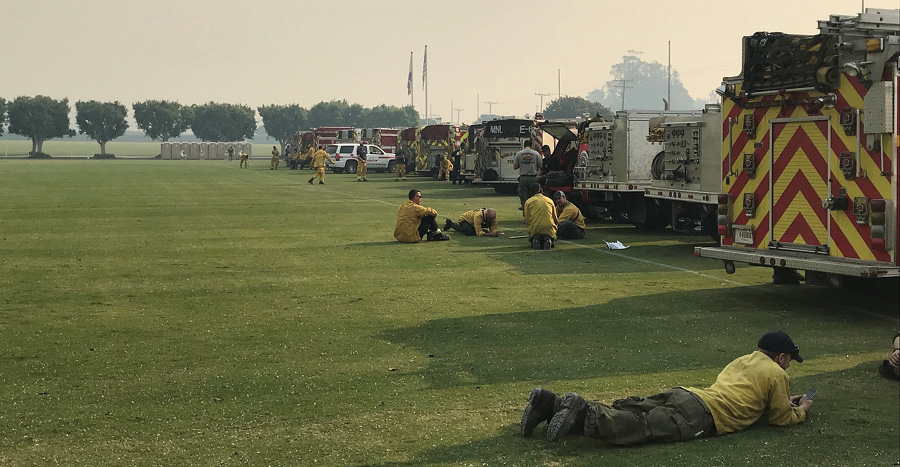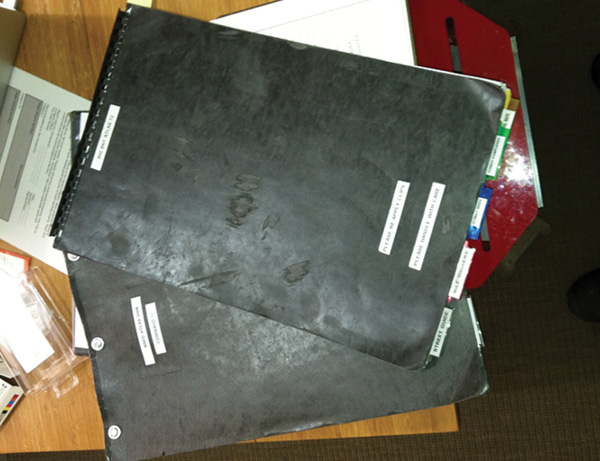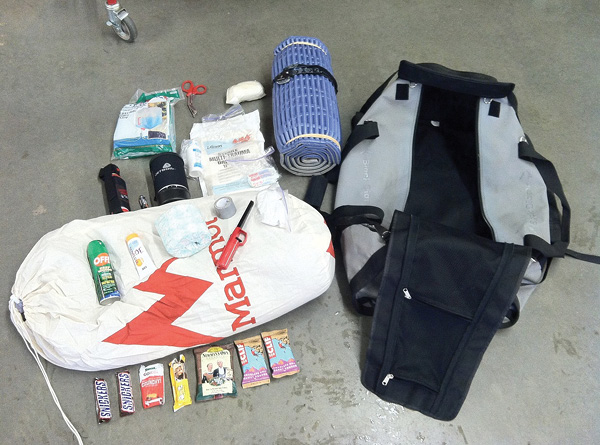BY SETH BARKER
Operational readiness is the key to success. Having and then executing a well-thought-out plan are essential when working in the emergency services. There are many facets to this strategy that every member in the organization needs to “own” to ensure everyone has all the necessary means to deliver on creating a standard that satisfies the customer. This can range from a simple concept such as a tactic or a complex theory stemming from a disaster plan. You must organize, practice, and research all aspects of this plan.

(1) Consider addressing the basic needs of all wildland firefighters so they can perform at their best. (Photos by author.)
Training
When we talk about operational readiness, we first think of training. When confronted with a problem, training is what most of us fall back on and can execute effectively; this is the reason training is the most important part of instituting operational readiness. To accomplish end goals such as customer stabilization, fire control, and clearing a scene, we must be well rehearsed at mitigating the problem. Training becomes the all-encompassing drive to ensure our members are proficient. It’s a solution with which everyone can agree.
However, what supports the training? Is it the department’s budget? Is it buy-in from the personnel? Is it the ever-passionate company officer who demands perfection? I will argue that it starts much deeper than that.
Home and Work-Life Balance
Like some of you, I find it increasingly difficult to find the balance between work and home. Being gone for hours and days on end and then returning home and trying to “switch gears” seems like a challenge that is not getting any easier. Recently, after returning from work, I was navigating my family morning routine dangerously close to my work demeanor. I was thinking, “Why is no one listening to me?” Then, my wife pulled me aside and brought to my attention that my family does not work for me; they are not under my command, nor do they need to follow my incident action plan for getting the kids off to school. I needed to stop being the officer and focus on being the parent. I needed to understand what everyone needed to be successful at their task. It seemed that, at that moment, two worlds collided and were unable to coexist.
On the surface, this was the easy way to dismiss this interaction. However, I needed to put the balance of these two worlds at the top of my list. Much like being at work, my wife and I need to support each other and succeed as a team. We need to identify what each other needs to effectively do our parts. The home needs must support the family and how we navigate through our day to be successful as a partner, a parent, and a friend. The little things support the big things, and the support system at home is the foundation for the actions taken during the day. Those daily actions lead to the preparation, practice, and skill needed to accommodate the problem.
While at work, we need to be far from the distractions that pull us away from being completely focused on the task at hand. In a sense, we leave one world to function in another. The world we leave needs to be balanced, well-thought-out, planned, and supported to function in the present. This takes an incredible amount of focus, thought, and insight to deliver functionality.

(2) Preplanning our WUI team’s equipment, support, and logistics can help them succeed when assigned to an event that demands focus.
You can apply this very basic concept to how you navigate our system for being proactive with operational readiness. If you focus on a well-thought-out plan in the beginning, you can support our end-user in operations confidently.
Focus on the Basics
This past year, we saw no shortage of tragedies in the fire service wildland urban interface (WUI). We saw countless homes destroyed, lives lost, and catastrophes affecting communities on the grandest of scales. Our thoughts and prayers were and are with all those affected during this past fire season. When smoke is in the air and news coverage is flooded with footage of extreme fire behavior, it is challenging for us to stay at home and not rush to aid our brothers and sisters.
In our culture, we want and need to help; this is where the training starts, balance begins, and preplanning commences. Being proactive when considering helping others is paramount. Leaders need to identify each member their organization needs before committing them to a hazardous environment. We must know the environment in which we are operating now and will potentially operate in the future to preplan our training, logistics, and tactics so our team is as prepared as it can be.
When considering operating in the WUI, focus on the basics such as solid tactics, weather, fuel loads, water supply and shuttling, topography, and access. However, to support the basics, everything else needs to fall into place to ensure you demonstrate competency—not complacency.
Recently, my department deployed part of our membership to California to help our members in the emergency services during a time of need. (To say our team left a comfortable world of familiarity is an understatement.) Traveling more than 44 hours in a structure engine to a place that is foreign and dangerous is daunting. Our team had to feel well supported when leaving their world before they could safely and effectively operate in the new one. Our team had to be well trained and competent to operate for other agencies and jurisdictions, especially when compounded with the stress of a high-intensity WUI environment. Teams that are tasked with tactics and strategies in an intense wildland incident must rely on their training and competence. To support the training, we can institute fundamental concepts to make sure each member is supported.
Deployment Preparation
When preplanning for successful operational readiness at a WUI event, we can now dig deeper. How can we address the needs of troops on the ground so they can address the task at hand? A well-thought-out logistical plan for deployments is one of the keys to success. Consider what everyone needs on deployments. You can take simple things into account to make the troops more comfortable, addressing the basic needs of all wildland firefighters so they can perform at their best.

(3) A well-thought-out logistical plan for deployments is one of the keys to success.
Deployment packs. Most firefighters have been using this fundamental concept for years. Prepack a pack with essentials to spend time away from the comforts of your home or fire station. This pack should include a sleeping bag, toiletries, shelter, rain gear, a sleeping pad, and quick and easy meals. A pack that is easily transferable across the whole organization takes stress off each member when time is the key element while responding for a deployment.
Maps. Front-load your team with accurate and dependable maps of the area to which they are responding. Don’t expect the agency that requested you to have all the necessary logistical tools when you arrive; it is overwhelmed, to say the least. Accomplish as much as you can for yourself so that when you do obtain the necessary tools to do your job it makes your life that much easier. There are multiple online and offline options to consider. Do your research and be prepared.
The “right tools for the job.” Have a checklist of all necessary equipment that has been inventoried and maintained during your wildland season. Make sure you have programmable radios in good working order. Check and rehab all wildland packs and shelters to know they are in a state of readiness.
Apparatus. Make sure your apparatus is the right rig for the right job. This is another area where you need to do your research. An apparatus that is clean, organized, and functional for the assignment seems to be obvious. In other words, don’t take a knife to a gunfight.
Preplanning for Success
Preplanning your WUI team’s equipment, support, and logistics can help them succeed when assigned to an event that demands focus. When we send our teams to the edge of the world to help others in need, the plan needs to be sharp and polished. Everyone knows and understands that we need to train smarter and more often. Support the training by thinking about your team’s basic needs. These basic needs constitute a plan that you can form into action. When we leave our home to go to work, we know that our home, family, and general needs are taken care of; this way, we can focus on being the best responders for our customers. Institute the same methodology at work when we leave to go help others. Support from our agency, community, and coworkers is paramount.

(4) Have a pack prepacked with essentials to spend time away from the comforts of your home or fire station.
Identify the little things that make a big difference. Focus on what you need and make the changes so you are proactive and not reactive. When we leave our homes to go to work or go from work to another state, we leave behind one world and enter a new one. Let’s make sure the support is there so everyone comes home.
SETH BARKER is a battalion chief and training officer for the Big Sky (MT) Fire Department. He is also a state fire instructor for the Montana Fire Service Training School, a state lead EMS instructor, a certified live fire instructor, and a training officer through the International Society of Fire Service Instructors (ISFSI). Barker has Blue Card instructor certification and is an ISFSI instructor and a logistical coordinator for FirefighterCloseCalls.com. He is part of the curriculum development team for the ISFSI and is one of its “Principles of Modern Fire Attack” instructors and instructor trainers. He is second vice president and sits on the executive board of the ISFSI. Barker also has fire officer and chief training officer designations from the Center for Public Safety Excellence.

